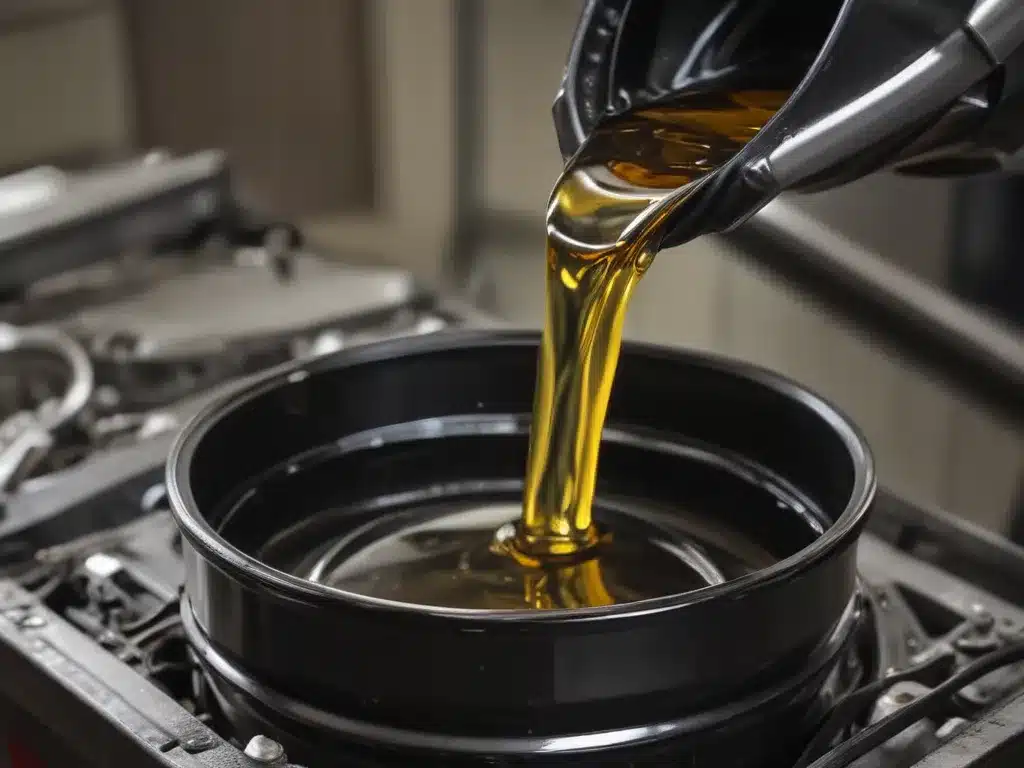
The Mysterious Origins of Synthetic Motor Oil
I’ve always been fascinated by the inner workings of the automotive world. As a gearhead and self-proclaimed “motor oil enthusiast” (yes, that’s a real thing!), I can’t help but wonder – how exactly does synthetic motor oil come into existence? It’s like some kind of automotive alchemy, transforming base oils into a magical elixir that keeps our engines purring.
Let me take you on a journey into the captivating process of synthetic motor oil production. Buckle up, because this is about to get nerdy – in the best way possible.
Breaking Down the Basics
To begin, we need to understand the fundamental differences between conventional and synthetic motor oils. Conventional oils are refined directly from crude oil, a naturally occurring fossil fuel. Synthetic oils, on the other hand, are created through a complex chemical process that essentially “man-made” from scratch.
The key to synthetic oil’s superior performance lies in its molecular structure. Conventional oils are made up of a random assortment of hydrocarbon molecules, which can vary greatly in size and shape. Synthetic oils, in contrast, are engineered to have a more uniform, consistent molecular structure. This allows for enhanced lubrication, improved resistance to thermal breakdown, and better overall protection for your engine.
The Synthetic Oil Manufacturing Process
So, how exactly does this manufacturing magic happen? The process can be broken down into a few crucial steps:
Step 1: Selecting the Base Stocks
The journey begins with carefully selecting the base stocks – the raw materials that will be transformed into synthetic oil. These are typically high-quality, pure hydrocarbons derived from natural gas or other refined sources. The specific base stocks chosen will depend on the desired performance characteristics of the final product.
Step 2: The Synthesis Reaction
Next comes the synthesis reaction, where the base stocks are combined with various additives and subjected to intense heat and pressure. This complex chemical process rearranges the molecular structure of the hydrocarbons, creating the uniform, “man-made” molecules that define synthetic oil.
Step 3: Refining and Blending
After the synthesis, the oil undergoes extensive refining and blending to ensure it meets rigorous quality standards. This may involve further purification, the addition of specialized additives, and precise adjustments to the molecular makeup.
Step 4: Quality Assurance
The final step is comprehensive testing and quality assurance. Synthetic oils must undergo a battery of checks to ensure they meet or exceed industry performance specifications. This includes evaluating factors like viscosity, oxidation resistance, and cold-weather flow.
The Advantages of Synthetic Oil
So, why all the fuss over synthetic oil? What makes it so special compared to its conventional counterpart? Well, let me tell you, the benefits are numerous and undeniable:
-
Improved Engine Protection: The uniform molecular structure of synthetic oil provides superior lubrication, reducing friction and wear on critical engine components. This translates to longer engine life and better performance over time.
-
Enhanced Fuel Efficiency: Synthetic oils have lower viscosity, meaning they flow more easily. This reduced internal engine drag, leading to improved fuel efficiency and lower emissions.
-
Extended Oil Change Intervals: Synthetic oils are more resistant to thermal breakdown and oxidation, allowing for longer recommended oil change intervals. This saves time, money, and the hassle of more frequent maintenance.
-
Reliable Performance in Extreme Conditions: Whether it’s the scorching heat of the desert or the bitter cold of the tundra, synthetic oils maintain their optimal viscosity and flow characteristics, ensuring reliable performance in a wide range of operating conditions.
Real-World Synthetic Oil Success Stories
Don’t just take my word for it – let’s look at some real-world examples of synthetic oil’s impressive capabilities:
Case Study: The Alaskan Challenge
In the remote, frigid conditions of Alaska, a team of hardy mechanics put synthetic oil to the test. They subjected a fleet of heavy-duty trucks to the harshest winter imaginable, with temperatures plunging well below freezing. Despite the extreme cold, the synthetic oil maintained its viscosity, allowing the engines to start up reliably and perform flawlessly throughout the challenging conditions.
Interview: The Racetrack Perspective
I recently had the chance to sit down with a professional race car driver, who shared his insights on the importance of synthetic oil. “When you’re pushing an engine to the absolute limit, like we do on the racetrack, conventional oil just can’t keep up,” he explained. “Synthetic oil’s resistance to thermal breakdown and its ability to maintain optimal lubrication is what gives us that extra edge in performance and reliability.”
Embracing the Future of Motor Oil
As we delve deeper into the world of automotive technology, it’s clear that synthetic motor oil is leading the charge. Its superior performance, enhanced protection, and increased efficiency make it an essential component in keeping our vehicles running at their best.
The next time you’re pondering the mysteries of the automotive universe, I hope you’ll consider the captivating origins and remarkable capabilities of synthetic motor oil. It’s a true marvel of modern engineering, and I’m proud to be a part of this ever-evolving industry.
So, the next time you’re due for an oil change, don’t settle for anything less than the best. Embrace the power of synthetic and let your engine experience the difference. Who knows, you might even become a motor oil enthusiast like me!


